[English] 日本語
 Yorodumi
Yorodumi- EMDB-22689: Hedgehog receptor Patched (PTCH1) in complex with conformation se... -
+ Open data
Open data
- Basic information
Basic information
| Entry | Database: EMDB / ID: EMD-22689 | ||||||||||||
|---|---|---|---|---|---|---|---|---|---|---|---|---|---|
| Title | Hedgehog receptor Patched (PTCH1) in complex with conformation selective nanobody TI23 | ||||||||||||
 Map data Map data | Sharpened map of Patched in complex with nanobody TI23 | ||||||||||||
 Sample Sample |
| ||||||||||||
 Keywords Keywords | MEMBRANE PROTEIN | ||||||||||||
| Function / homology |  Function and homology information Function and homology informationLigand-receptor interactions / Activation of SMO / neural plate axis specification / response to chlorate / cell differentiation involved in kidney development / hedgehog receptor activity / cell proliferation involved in metanephros development / neural tube formation / smoothened binding / hedgehog family protein binding ...Ligand-receptor interactions / Activation of SMO / neural plate axis specification / response to chlorate / cell differentiation involved in kidney development / hedgehog receptor activity / cell proliferation involved in metanephros development / neural tube formation / smoothened binding / hedgehog family protein binding / hindlimb morphogenesis / Hedgehog 'on' state / epidermal cell fate specification / spinal cord motor neuron differentiation / prostate gland development / Hedgehog 'off' state / patched binding / negative regulation of cell division / somite development / smooth muscle tissue development / dorsal/ventral neural tube patterning / pharyngeal system development / cellular response to cholesterol / mammary gland duct morphogenesis / pattern specification process / mammary gland epithelial cell differentiation / cell fate determination / commissural neuron axon guidance / metanephric collecting duct development / mammary gland development / dorsal/ventral pattern formation / regulation of growth / embryonic limb morphogenesis / negative regulation of multicellular organism growth / branching involved in ureteric bud morphogenesis / cholesterol binding / positive regulation of epidermal cell differentiation / dendritic growth cone / keratinocyte proliferation / spermatid development / epidermis development / positive regulation of cholesterol efflux / negative regulation of keratinocyte proliferation / embryonic organ development / response to retinoic acid / negative regulation of osteoblast differentiation / response to mechanical stimulus / axonal growth cone / heart morphogenesis / negative regulation of stem cell proliferation / liver regeneration / cyclin binding / regulation of mitotic cell cycle / animal organ morphogenesis / epithelial cell proliferation / stem cell proliferation / protein localization to plasma membrane / negative regulation of smoothened signaling pathway / neural tube closure / brain development / caveola / protein processing / negative regulation of epithelial cell proliferation / apical part of cell / response to estradiol / glucose homeostasis / heparin binding / regulation of cell population proliferation / regulation of protein localization / midbody / in utero embryonic development / postsynaptic membrane / cilium / response to xenobiotic stimulus / negative regulation of cell population proliferation / negative regulation of DNA-templated transcription / positive regulation of DNA-templated transcription / protein-containing complex binding / perinuclear region of cytoplasm / negative regulation of transcription by RNA polymerase II / Golgi apparatus / signal transduction / extracellular region / zinc ion binding / plasma membrane Similarity search - Function | ||||||||||||
| Biological species |   | ||||||||||||
| Method | single particle reconstruction / cryo EM / Resolution: 3.4 Å | ||||||||||||
 Authors Authors | Zhang Y / Bulkley DP | ||||||||||||
| Funding support |  United States, 3 items United States, 3 items
| ||||||||||||
 Citation Citation |  Journal: Proc Natl Acad Sci U S A / Year: 2020 Journal: Proc Natl Acad Sci U S A / Year: 2020Title: Hedgehog pathway activation through nanobody-mediated conformational blockade of the Patched sterol conduit. Authors: Yunxiao Zhang / Wan-Jin Lu / David P Bulkley / Jiahao Liang / Arthur Ralko / Shuo Han / Kelsey J Roberts / Anping Li / Wonhwa Cho / Yifan Cheng / Aashish Manglik / Philip A Beachy /  Abstract: Activation of the Hedgehog pathway may have therapeutic value for improved bone healing, taste receptor cell regeneration, and alleviation of colitis or other conditions. Systemic pathway activation, ...Activation of the Hedgehog pathway may have therapeutic value for improved bone healing, taste receptor cell regeneration, and alleviation of colitis or other conditions. Systemic pathway activation, however, may be detrimental, and agents amenable to tissue targeting for therapeutic application have been lacking. We have developed an agonist, a conformation-specific nanobody against the Hedgehog receptor Patched1 (PTCH1). This nanobody potently activates the Hedgehog pathway in vitro and in vivo by stabilizing an alternative conformation of a Patched1 "switch helix," as revealed by our cryogenic electron microscopy structure. Nanobody-binding likely traps Patched in one stage of its transport cycle, thus preventing substrate movement through the Patched1 sterol conduit. Unlike the native Hedgehog ligand, this nanobody does not require lipid modifications for its activity, facilitating mechanistic studies of Hedgehog pathway activation and the engineering of pathway activating agents for therapeutic use. Our conformation-selective nanobody approach may be generally applicable to the study of other PTCH1 homologs. | ||||||||||||
| History |
|
- Structure visualization
Structure visualization
| Movie |
 Movie viewer Movie viewer |
|---|---|
| Structure viewer | EM map:  SurfView SurfView Molmil Molmil Jmol/JSmol Jmol/JSmol |
| Supplemental images |
- Downloads & links
Downloads & links
-EMDB archive
| Map data |  emd_22689.map.gz emd_22689.map.gz | 59.4 MB |  EMDB map data format EMDB map data format | |
|---|---|---|---|---|
| Header (meta data) |  emd-22689-v30.xml emd-22689-v30.xml emd-22689.xml emd-22689.xml | 22.1 KB 22.1 KB | Display Display |  EMDB header EMDB header |
| Images |  emd_22689.png emd_22689.png | 127.3 KB | ||
| Filedesc metadata |  emd-22689.cif.gz emd-22689.cif.gz | 7.3 KB | ||
| Others |  emd_22689_half_map_1.map.gz emd_22689_half_map_1.map.gz emd_22689_half_map_2.map.gz emd_22689_half_map_2.map.gz | 18.3 MB 2.8 MB | ||
| Archive directory |  http://ftp.pdbj.org/pub/emdb/structures/EMD-22689 http://ftp.pdbj.org/pub/emdb/structures/EMD-22689 ftp://ftp.pdbj.org/pub/emdb/structures/EMD-22689 ftp://ftp.pdbj.org/pub/emdb/structures/EMD-22689 | HTTPS FTP |
-Validation report
| Summary document |  emd_22689_validation.pdf.gz emd_22689_validation.pdf.gz | 839.7 KB | Display |  EMDB validaton report EMDB validaton report |
|---|---|---|---|---|
| Full document |  emd_22689_full_validation.pdf.gz emd_22689_full_validation.pdf.gz | 839.3 KB | Display | |
| Data in XML |  emd_22689_validation.xml.gz emd_22689_validation.xml.gz | 12.6 KB | Display | |
| Data in CIF |  emd_22689_validation.cif.gz emd_22689_validation.cif.gz | 14.8 KB | Display | |
| Arichive directory |  https://ftp.pdbj.org/pub/emdb/validation_reports/EMD-22689 https://ftp.pdbj.org/pub/emdb/validation_reports/EMD-22689 ftp://ftp.pdbj.org/pub/emdb/validation_reports/EMD-22689 ftp://ftp.pdbj.org/pub/emdb/validation_reports/EMD-22689 | HTTPS FTP |
-Related structure data
| Related structure data |  7k65MC M: atomic model generated by this map C: citing same article ( |
|---|---|
| Similar structure data | |
| EM raw data |  EMPIAR-10328 (Title: Hedgehog receptor Patched (PTCH1) in complex with a conformation selective nanobody TI23 EMPIAR-10328 (Title: Hedgehog receptor Patched (PTCH1) in complex with a conformation selective nanobody TI23Data size: 75.2 Data #1: Particle stack of Hedgehog receptor PTCH1 in complex with nanobody TI23 for final reconstruction [picked particles - multiframe - processed]) |
- Links
Links
| EMDB pages |  EMDB (EBI/PDBe) / EMDB (EBI/PDBe) /  EMDataResource EMDataResource |
|---|---|
| Related items in Molecule of the Month |
- Map
Map
| File |  Download / File: emd_22689.map.gz / Format: CCP4 / Size: 64 MB / Type: IMAGE STORED AS FLOATING POINT NUMBER (4 BYTES) Download / File: emd_22689.map.gz / Format: CCP4 / Size: 64 MB / Type: IMAGE STORED AS FLOATING POINT NUMBER (4 BYTES) | ||||||||||||||||||||||||||||||||||||||||||||||||||||||||||||
|---|---|---|---|---|---|---|---|---|---|---|---|---|---|---|---|---|---|---|---|---|---|---|---|---|---|---|---|---|---|---|---|---|---|---|---|---|---|---|---|---|---|---|---|---|---|---|---|---|---|---|---|---|---|---|---|---|---|---|---|---|---|
| Annotation | Sharpened map of Patched in complex with nanobody TI23 | ||||||||||||||||||||||||||||||||||||||||||||||||||||||||||||
| Projections & slices | Image control
Images are generated by Spider. | ||||||||||||||||||||||||||||||||||||||||||||||||||||||||||||
| Voxel size | X=Y=Z: 1.059 Å | ||||||||||||||||||||||||||||||||||||||||||||||||||||||||||||
| Density |
| ||||||||||||||||||||||||||||||||||||||||||||||||||||||||||||
| Symmetry | Space group: 1 | ||||||||||||||||||||||||||||||||||||||||||||||||||||||||||||
| Details | EMDB XML:
CCP4 map header:
| ||||||||||||||||||||||||||||||||||||||||||||||||||||||||||||
-Supplemental data
-Half map: half map 1
| File | emd_22689_half_map_1.map | ||||||||||||
|---|---|---|---|---|---|---|---|---|---|---|---|---|---|
| Annotation | half map 1 | ||||||||||||
| Projections & Slices |
| ||||||||||||
| Density Histograms |
-Half map: Half map 2
| File | emd_22689_half_map_2.map | ||||||||||||
|---|---|---|---|---|---|---|---|---|---|---|---|---|---|
| Annotation | Half map 2 | ||||||||||||
| Projections & Slices |
| ||||||||||||
| Density Histograms |
- Sample components
Sample components
-Entire : Complex between Hedgehog receptor PTCH1 and nanobody TI23
| Entire | Name: Complex between Hedgehog receptor PTCH1 and nanobody TI23 |
|---|---|
| Components |
|
-Supramolecule #1: Complex between Hedgehog receptor PTCH1 and nanobody TI23
| Supramolecule | Name: Complex between Hedgehog receptor PTCH1 and nanobody TI23 type: complex / ID: 1 / Parent: 0 / Macromolecule list: #1-#2 |
|---|
-Supramolecule #2: Hedgehog receptor Patched PTCH1
| Supramolecule | Name: Hedgehog receptor Patched PTCH1 / type: complex / ID: 2 / Parent: 1 / Macromolecule list: #1 |
|---|---|
| Source (natural) | Organism:  |
-Supramolecule #3: nanobody TI23
| Supramolecule | Name: nanobody TI23 / type: complex / ID: 3 / Parent: 1 / Macromolecule list: #2 |
|---|---|
| Source (natural) | Organism:  |
-Macromolecule #1: Protein patched homolog 1
| Macromolecule | Name: Protein patched homolog 1 / type: protein_or_peptide / ID: 1 / Number of copies: 1 / Enantiomer: LEVO |
|---|---|
| Source (natural) | Organism:  |
| Molecular weight | Theoretical: 142.619938 KDa |
| Recombinant expression | Organism:  Homo sapiens (human) Homo sapiens (human) |
| Sequence | String: MASAGNAAGA LGRQAGGGRR RRTGGPHRAA PDRDYLHRPS YCDAAFALEQ ISKGKATGRK APLWLRAKFQ RLLFKLGCYI QKNCGKFLV VGLLIFGAFA VGLKAANLET NVEELWVEVG GRVSRELNYT RQKIGEEAMF NPQLMIQTPK EEGANVLTTE A LLQHLDSA ...String: MASAGNAAGA LGRQAGGGRR RRTGGPHRAA PDRDYLHRPS YCDAAFALEQ ISKGKATGRK APLWLRAKFQ RLLFKLGCYI QKNCGKFLV VGLLIFGAFA VGLKAANLET NVEELWVEVG GRVSRELNYT RQKIGEEAMF NPQLMIQTPK EEGANVLTTE A LLQHLDSA LQASRVHVYM YNRQWKLEHL CYKSGELITE TGYMDQIIEY LYPCLIITPL DCFWEGAKLQ SGTAYLLGKP PL RWTNFDP LEFLEELKKI NYQVDSWEEM LNKAEVGHGY MDRPCLNPAD PDCPATAPNK NSTKPLDVAL VLNGGCQGLS RKY MHWQEE LIVGGTVKNA TGKLVSAHAL QTMFQLMTPK QMYEHFRGYD YVSHINWNED RAAAILEAWQ RTYVEVVHQS VAPN STQKV LPFTTTTLDD ILKSFSDVSV IRVASGYLLM LAYACLTMLR WDCSKSQGAV GLAGVLLVAL SVAAGLGLCS LIGIS FNAA TTQVLPFLAL GVGVDDVFLL AHAFSETGQN KRIPFEDRTG ECLKRTGASV ALTSISNVTA FFMAALIPIP ALRAFS LQA AVVVVFNFAM VLLIFPAILS MDLYRREDRR LDIFCCFTSP CVSRVIQVEP QAYTEPMQST VQLRTEYDPH THVYYTT AE PRSEISVQPV TVTQDNLSCQ SPESTSSTRD LLSQFSDSSL HCLEPPCTKW TLSSFAEKHY APFLLKPKAK VVVILLFL G LLGVSLYGTT RVRDGLDLTD IVPRETREYD FIAAQFKYFS FYNMYIVTQK ADYPNIQHLL YDLHKSFSNV KYVMLEENK QLPQMWLHYF RDWLQGLQDA FDSDWETGRI MPNNYKNGSD DGVLAYKLLV QTGSRDKPID ISQLTKQRLV DADGIINPSA FYIYLTAWV SNDPVAYAAS QANIRPHRPE WVHDKADYMP ETRLRIPAAE PIEYAQFPFY LNGLRDTSDF VEAIEKVRVI C NNYTSLGL SSYPNGYPFL FWEQYISLRH WLLLSISVVL ACTFLVCAVF LLNPWTAGII VMVLALMTVE LFGMMGLIGI KL SAVPVVI LIASVGIGVE FTVHVALAFL TAIGDKNHRA MLALEHMFAP VLDGAVSTLL GVLMLAGSEF DFIVRYFFAV LAI LTVLGV LNGLVLLPVL LSFFGPCPEV SPANGLNRLP TPSPEPPPSV VRFAVPPGHT NNGSDSSDSE YSSQTTVSGI SEEL RQYEA QQGAGGPAHQ VIVEATENPV FARSTVVHPD SRHQPPLTPR QQPHLDSGSL SPGRQGQQPR RDMDEKTTGW RGGHV V UniProtKB: Protein patched homolog 1 |
-Macromolecule #2: nanobody TI23
| Macromolecule | Name: nanobody TI23 / type: protein_or_peptide / ID: 2 / Number of copies: 1 / Enantiomer: LEVO |
|---|---|
| Source (natural) | Organism:  |
| Molecular weight | Theoretical: 13.821417 KDa |
| Recombinant expression | Organism:  |
| Sequence | String: QVQLQESGGG LVQAGGSLRL SCAASGNIFA YYIMGWYRQA PGKERELVAT IDIGGNTNYA DSVKGRFTIS RDNAKNNVYL QMNSLKPED TAVYYCAVQA VPIRYRRYWG QGTQVTVSSH HHHHH |
-Macromolecule #4: 2-acetamido-2-deoxy-beta-D-glucopyranose
| Macromolecule | Name: 2-acetamido-2-deoxy-beta-D-glucopyranose / type: ligand / ID: 4 / Number of copies: 5 / Formula: NAG |
|---|---|
| Molecular weight | Theoretical: 221.208 Da |
| Chemical component information |  ChemComp-NAG: |
-Macromolecule #5: 2-{[(4-O-alpha-D-glucopyranosyl-alpha-D-glucopyranosyl)oxy]methyl...
| Macromolecule | Name: 2-{[(4-O-alpha-D-glucopyranosyl-alpha-D-glucopyranosyl)oxy]methyl}-4-{[(3beta,9beta,14beta,17beta,25R)-spirost-5-en-3-yl]oxy}butyl 4-O-alpha-D-glucopyranosyl-alpha-D-glucopyranoside type: ligand / ID: 5 / Number of copies: 4 / Formula: Q7G |
|---|---|
| Molecular weight | Theoretical: 1.165315 KDa |
| Chemical component information |  ChemComp-Q7G: |
-Experimental details
-Structure determination
| Method | cryo EM |
|---|---|
 Processing Processing | single particle reconstruction |
| Aggregation state | particle |
- Sample preparation
Sample preparation
| Concentration | 4.5 mg/mL | ||||||||||||
|---|---|---|---|---|---|---|---|---|---|---|---|---|---|
| Buffer | pH: 8 Component:
| ||||||||||||
| Grid | Model: Quantifoil | ||||||||||||
| Vitrification | Cryogen name: ETHANE / Chamber humidity: 100 % / Chamber temperature: 298 K / Instrument: FEI VITROBOT MARK III |
- Electron microscopy
Electron microscopy
| Microscope | FEI TITAN KRIOS |
|---|---|
| Image recording | Film or detector model: GATAN K2 SUMMIT (4k x 4k) / Detector mode: SUPER-RESOLUTION / Digitization - Dimensions - Width: 3838 pixel / Digitization - Dimensions - Height: 3710 pixel / Number real images: 7046 / Average exposure time: 12.0 sec. / Average electron dose: 85.6 e/Å2 |
| Electron beam | Acceleration voltage: 300 kV / Electron source:  FIELD EMISSION GUN FIELD EMISSION GUN |
| Electron optics | Illumination mode: FLOOD BEAM / Imaging mode: BRIGHT FIELD |
| Sample stage | Specimen holder model: FEI TITAN KRIOS AUTOGRID HOLDER / Cooling holder cryogen: NITROGEN |
| Experimental equipment |  Model: Titan Krios / Image courtesy: FEI Company |
 Movie
Movie Controller
Controller


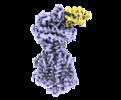
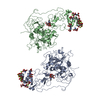

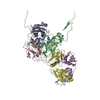

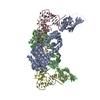


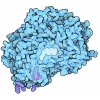


 Z (Sec.)
Z (Sec.) Y (Row.)
Y (Row.) X (Col.)
X (Col.)






































